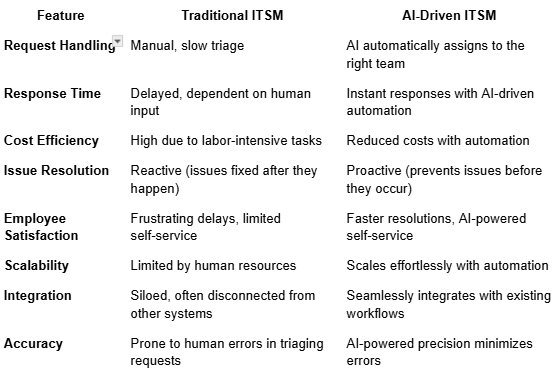IT Service Management (ITSM), relying on methodologies such as ITIL in ITSM, has always been the backbone of internal support. Whether it’s handling service requests from employees, troubleshooting access issues, or triaging to the correct team, a well-run ITSM system keeps businesses running smoothly.
But here’s the thing—traditional ITSM tools just aren’t cutting it anymore.
They rely on manual processes, outdated workflows, and reactive approaches that slow everything down. Employees get frustrated waiting for help, and IT admins get stuck dealing with the same issues over and over.
This is where AI-driven ITSM steps in, and Siit is leading the charge. Let’s break down why AI-powered ITSM is a total game changer and how it stacks up against traditional tools.
Traditional ITSM Tools: The Old-School Approach
Before AI came into the picture, ITSM relied on structured workflows and human intervention to resolve issues. While these tools provided a framework for managing requests, they had some major drawbacks:
- Manual Processes: Requests often had to be manually assigned and resolved, leading to bottlenecks.
- Reactive Support: IT teams would respond only after issues were reported, rather than preventing them.
- Siloed Systems: Lack of integration meant information was scattered, making collaboration difficult.
- Slow Resolution Times: Employees had to wait for IT admins to process and resolve requests.
The result? A frustrating experience for employees and an overwhelmed IT team.
The AI-Powered Shift in ITSM
AI-driven ITSM flips the script. Instead of relying on humans to handle every request manually, AI automates repetitive tasks, predicts issues before they happen, and streamlines internal operations.
With AI in the mix, ITSM evolves from a slow, reactive process to a smart, self-improving system. Here’s what that looks like:
- Automated Ticket Routing: AI instantly categorizes and performs AI ticket triage to send requests to the correct team, reducing delays.
- AI-Powered Self-Service: Employees get instant answers from AI chatbots without waiting for an IT admin.
- Predictive Analytics: Machine learning detects potential IT issues before they disrupt operations.
- Seamless Integrations: AI-driven ITSM connects with existing workflows, reducing friction in IT operations.
AI-Driven ITSM vs. Traditional Tools: A Side-by-Side Comparison
Let’s get into the nitty-gritty. How does AI-driven ITSM really compare to traditional tools? Here’s a full breakdown of the key differences:

Why Does This Matter?
Traditional ITSM tools often leave IT teams drowning in repetitive tasks. AI-driven ITSM, on the other hand, acts as a smart assistant—automating tasks, predicting potential issues, and giving employees quick resolutions. The result? Happier employees, a more efficient IT team, and a smoother workflow across the board.
How Siit is Changing the ITSM Landscape
Siit isn’t just another ITSM platform—it’s built from the ground up to harness AI and automation. Unlike clunky legacy tools, Siit is designed to make ITSM seamless, intuitive, and actually enjoyable for IT admins and employees alike. Here’s how Siit is taking ITSM to the next level:
1. Smart Automation for Faster Resolutions
With Siit, there’s no waiting around for someone to manually sort through requests. AI takes care of the triaging process instantly, sending each request to the right team without human intervention. This not only cuts down response times dramatically but also helps to elevate service desk efficiency, freeing up IT admins to focus on more complex issues.
2. AI-Powered Self-Service
Why should employees have to wait in line for simple IT fixes? Siit’s AI-powered self-service capabilities empower employees to get the answers they need—fast. Whether it’s resetting a password, gaining access to a tool, or troubleshooting an issue, Siit’s chatbot can handle it in seconds.
3. Predictive IT Management
Instead of just reacting to IT issues, Siit gets ahead of them. Using predictive analytics and IT Operations Analytics, it can identify trends and potential problems before they escalate. This means IT teams can proactively address issues, reducing downtime and improving overall system stability. This proactive approach helps to enhance IT team efficiency, as they can focus on preventing issues rather than constantly putting out fires.
4. Seamless Integrations with Existing Workflows
No need to overhaul your entire system—Siit integrates smoothly with your existing IT infrastructure. Whether you're using Slack, Microsoft Teams, or tools for IT asset management and software license management, or integrating with Jamf Pro, Siit fits right in, making the transition effortless.
5. Employee-Friendly ITSM
Let’s be real—traditional ITSM tools weren’t exactly designed with employees in mind. Siit flips the script by prioritizing employee satisfaction, providing fast, AI-powered solutions, including an IT help desk in Slack, that make IT interactions smooth and frustration-free..
What’s Next? The Future of AI in ITSM
The ITSM landscape is evolving rapidly, and AI is at the center of it. Here’s what’s coming:
- Hyper-Automation: More tasks will be handled end-to-end by AI, reducing the need for manual intervention.
- AI-Driven Observability: IT teams will have real-time insights into system health, preventing outages before they occur.
- Smarter, More Adaptive ITSM: AI will continuously learn and improve, making ITSM more efficient over time.
Siit is already paving the way for this future, ensuring that businesses can transition smoothly into the next era of IT service management.
Your ITSM Upgrade Starts Today
Traditional ITSM tools have served their purpose, but they’re no match for the speed, intelligence, and efficiency of AI-driven ITSM.
Siit is leading this transformation, helping businesses automate service requests from employees, triage issues faster, and prevent problems before they disrupt operations. If you’re ready to take your ITSM to the next level, it’s time to explore what Siit can do for you.
Want to see AI-driven ITSM in action? Book a demo with Siit today to learn more.






